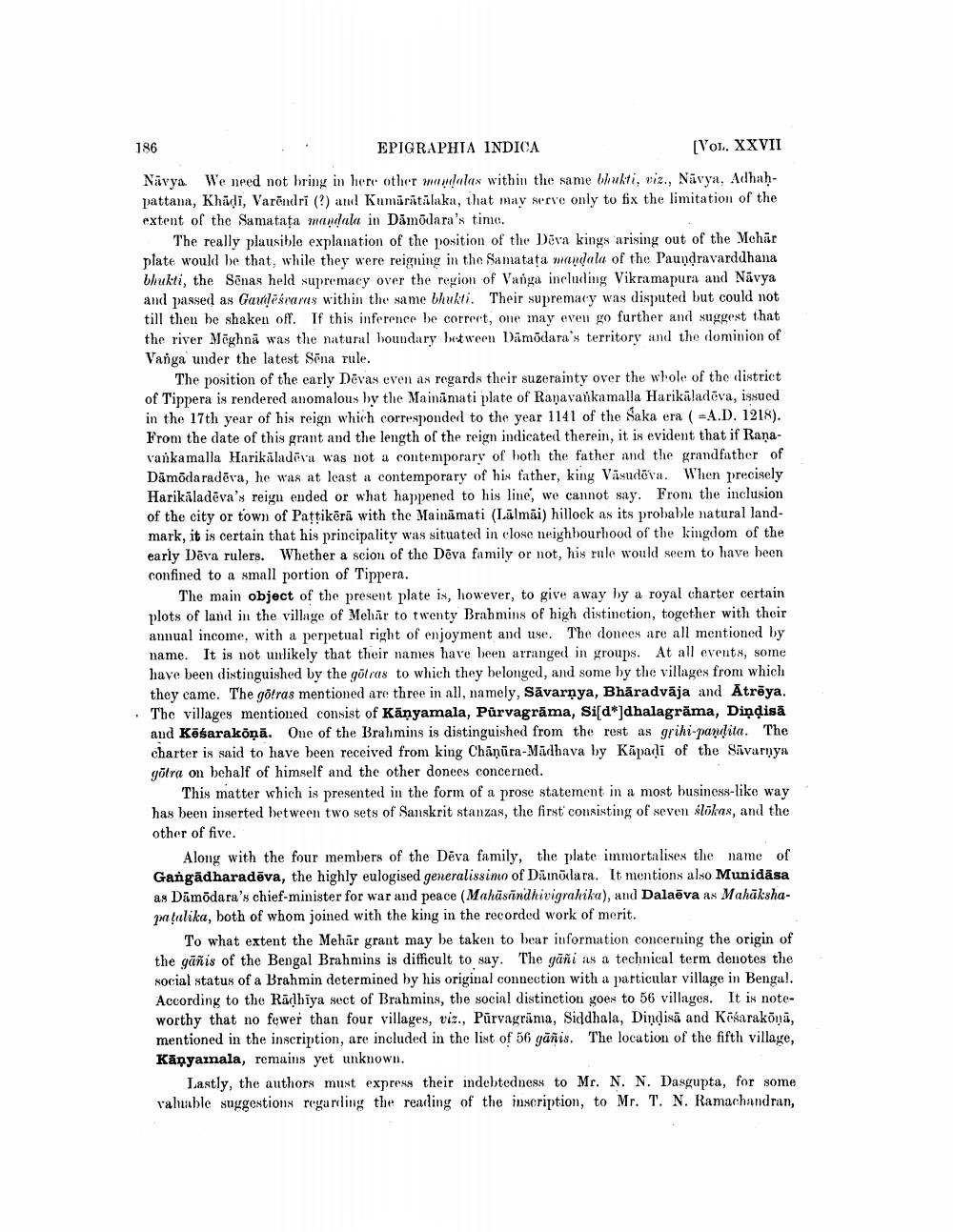________________
186
EPIGRAPHIA INDICA
[VOL. XXVII
Navya We need not bring in here other mamalax within the same bhukti, viz., Nivya, Adhah. pattana, Khadi, Varēndri (?) and Kumaritalaka, that may serve only to fix the limitation of the extent of the Sumataţa mandala in Dämõdara's time.
The really plausible explanation of the position of the Deva kings arising out of the Mchar plate would be that, while they were reigning in the Samatata madala of the laundravarddhana bhukti, the Sēnas held supremacy over the region of Vanga including Vikramapura and Navya and passed as Gardeners within the same bhukti. Their supremacy was disputed but could not till then be shaken off. If this inference be correct, one may even go further and suggest that the river Meghna was the natural boundary between Damodara's territory and the dominion of Vanga under the latest Sēna rule.
The position of the early Devas even as regards their suzerainty over the whole of the district of Tippera is rendered anomalous by the Mainimati plate of Ranavarkamalla Harikaladeva, issued in the 17th year of his reign which corresponded to the year 1141 of the Saka era ( A.D. 1218). From the date of this grant and the length of the reign indicated therein, it is evident that if Raņavankamalla Hariküladorit was not a contemporary of both the father and the grandfather of Dāmõdaradēva, he was at least a contemporary of his father, king Väsudova. When precisely Harikaladeva's reign ended or what happened to his line, we cannot say. From the inclusion of the city or town of Pattikērā with the Maināmati (Lālmāi) hillock as its probable natural landmark, it is certain that his principality was situated in close neighbourhood of the kingdom of the early Dēva rulers. Whether a scion of the Deva family or not, his rule would seem to have been confined to a small portion of Tippera.
The main object of the present plate is, however, to give away by a royal charter certain plots of land in the village of Mohar to twenty Brahmins of high distinction, together with their annual income, with a perpetual right of enjoyment and use. The donces are all mentioned by name. It is not unlikely that their names have been arranged in groups. At all events, some have been distinguished by the götras to which they belonged, and some by the villages from which they came. The götras mentioned are three in all, namely, Sāvarnya, Bhäradvāja and Atrēya. The villages mentioned consist of Kanyamala, Pūrvagrāma, Si[dk]dhalagrāma, Dindisā and Kēśaraköņā. One of the Brahmins is distinguished from the rest as grihi-pandita. The charter is said to have been received from king Chāņūra-Madhava by Kapadi of the Sivarnya götra on behalf of himself and the other donees concerned.
This matter which is presented in the form of a prose statement in a most business-like way has been inserted between two sets of Sanskrit stanzas, the first consisting of seven slokas, and the other of five.
Along with the four members of the Deva family, the plate immortalises the name of Gangādharadēva, the highly eulogised generalissino of Dämöilara. It mentions also Munidäsa as Damodara's chief minister for war and peace (Mahāsindhivigrahika), and Dalaēva as Mahūkshagaļalika, both of whom joined with the king in the recorded work of merit.
To what extent the Mehir grant may be taken to bear information concerning the origin of the gūsis of the Bengal Brahmins is difficult to say. The qani as a technical term denotes the social status of a Brahmin determined by his original connection with a particular village in Bengal. According to the Rādhiya sect of Brahmins, the social distinction goes to 56 villages. It is noteworthy that no fewer than four villages, viz., Pūrvagrama, Siddhala, Dindisã and Kökarakönä. mentioned in the inscription, are included in the list of 56 gañis. The location of the fifth village, Kāṇyamala, remains yet unknown.
Lastly, the authors must express their indebtedness to Mr. N. N. Dasgupta, for some valuable suggestions regarding the reading of the inscription, to Mr. T. N. Ramachandran,




